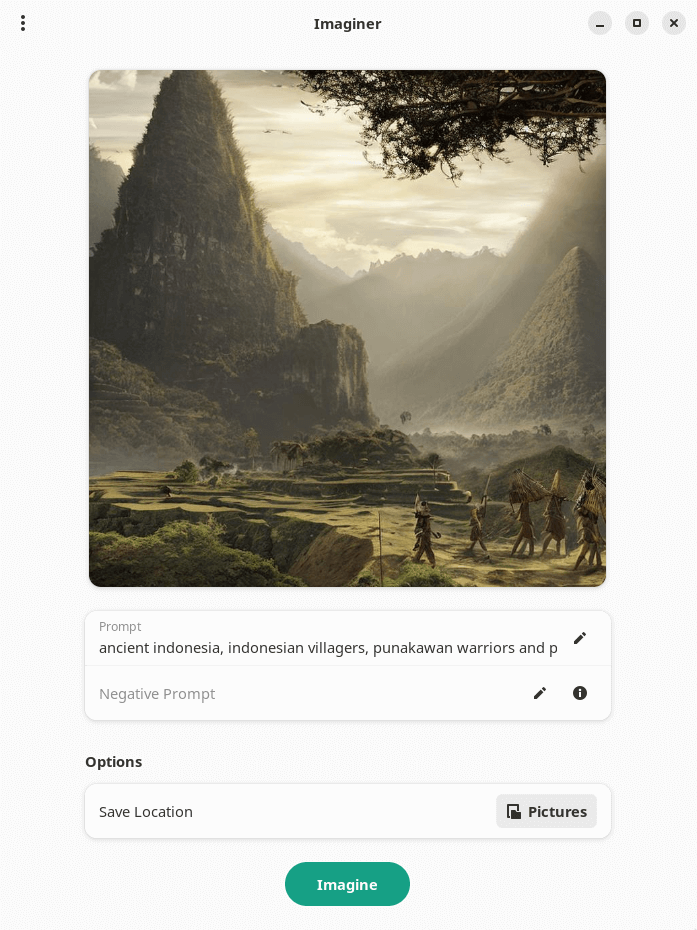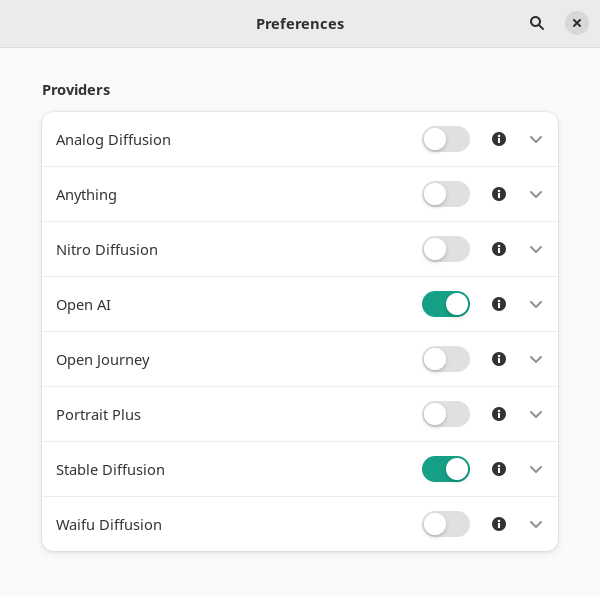Our Machine Learning in Linux series focuses on apps that make it easy to experiment with machine learning.
Imaginer is GTK4 software which lets you generate pictures using AI. You supply a text prompt, consisting of a collection of words to describe an image, and an AI model creates an image based on the words. Imaginer uses Stable Diffusion and other deep learning, text-to-image models to generate the images.
An extremely interesting area of research relates to these deep learning text-to-image models. We’ve published reviews of software that uses Stable Diffusion. Our reviews of Easy Diffusion, Stable Diffusion web UI, and InvokeAI noted each software program requires downloading large models. The software performs best when using a machine with a good dedicated graphics card. That’s not the case with Imaginer.
Installation
We tested Imaginer under Ubuntu 23.04 and Manjaro. There is a package in the Arch User Repository for Arch-based distros such as Manjaro. On our Ubuntu test system, we installed the software with Flatpak.
Issue the command:
$ flatpak install page.codeberg.Imaginer.Imaginer
In Operation
Imaginer has a really easy-to-use graphical interface. Enter a text prompt and click the Imagine button. What could be simpler!
Here’s example output generated with Imaginer.

You’ll see there’s the option to enter a negative prompt. They are the opposites of a prompt; they allow the user to tell the model what not to generate. Negative prompts often eliminate unwanted details like mangled hands or too many fingers or out of focus and blurry images.
By default two providers are enabled, but there are others to explore.

Summary
Imaginer gets a big thumbs-up.
It’s a different kettle of fish to the Stable Diffusion frontends we’ve previously explored. The tool lets you run AI models like Stable Diffusion even on obsolete hardware as the complex computation performed by the models does not run on your local computer. We highly recommend trying Imaginer if you’re interested in dabbling with AI art generated with text prompts and you’ve got an old computer with onboard graphics.
Imaginer is in a very early stage of development. The developer has recently added negative prompts which add some flexibility. We’re really looking forward to new releases of the software.
We’d love to see more functionality added to the program including the ability to download and run the models locally using the power of our GPU, and more flexibility when generating the images. For example, options to apply a custom VAE, prompt strengths, and changing the number of inference steps would be useful. These features could be added without affecting the simplicity of the software.
The icing on the cake would be incorporating other tools such as GFPGAN and CodeFormer face restoration tools, and Real-ESRGAN to upscale the images.
We recently published a capsule review of Bavarder, a really simple program to experiment with ChatGPT. Imaginer is written by the same developer.
Website: imaginer.codeberg.page
Support: Codeberg Code Repository, GitHub Code Repository
Developer: 0xMRTT
License: GNU General Public License v3.0
![]() For other useful open source apps that use machine learning/deep learning, we’ve compiled this roundup.
For other useful open source apps that use machine learning/deep learning, we’ve compiled this roundup.
Imaginer is written in Python. Learn Python with our recommended free books and free tutorials.

Sounds really good. Have installed Imaginer successfully. It seemed to be working because when I tried a prompt it led me to open the Providers page. I duly bought an OpenAI subscription and pasted in the API key. I set the save location. I left the file name default alone.
So I entered my first real prompt, “pretty asian girl in a white dress”
I got the circling “I’m thinking” prompt. It thought for two hours and did nothing. So exited the program using the the X in the corner. I entered my prompt again and let it run overnight. Still circling this morning.
What am I missing?
It appears that Imaginer has been deprecated. The developer stated in May 2024 that the project was being merged with Bavarder.
We looked at Bavarder in this review in 2023. But from a brief look, it’s not clear that image generation has been added to Bavarder.
If you’ve got a NVIDIA dedicated graphics card, I recommend trying Easy Diffusion, it’s very easy to install and generates attractive images from text prompts. Here’s my review. It’s maintained and works great.